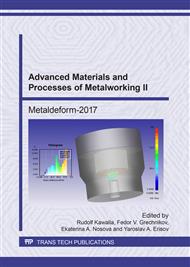[1]
V.M. Torbilo, Diamond burnishing, Mechanical Engineering, Moskow, (1972).
Google Scholar
[2]
A.N. Reznikov, Abrasive and diamond processing materials: a handbook, Mechanical Engineering, Moskow, (1977).
Google Scholar
[3]
P.G. Alekseev. Technology strengthening of machine parts surface plastic deformation. Tula, (1978).
Google Scholar
[4]
A.N. Shvetcov, D.L. Skuratov. Mathematical Model and Program Development for the Efficient Process Conditions Determination During FeC0. 15Cr12Ni2 Steel Diamond Smoothing, Key Engineering Materials, Vol. 684. (2016), 477-482.
DOI: 10.4028/www.scientific.net/kem.684.477
Google Scholar
[5]
V. Yu. Skeeba, V.V. Ivancivsky, D.V. Lobanov, A.K. Zhigulev, P. Yu. Skeeba. Integrated Processing: Quality Assurance Procedure of the Surface Layer of Machine Parts during the Manufacturing Step Diamond Smoothing, IOP Conference Series: Materials Science and Engineering, 125, (2016).
DOI: 10.1088/1757-899x/125/1/012031
Google Scholar
[6]
M. Korzynski, J. Lubas, S. Swirad, K. Dudek, Surface layer characteristics due to slide diamond burnishing with a cylindrical-ended tool, Journal of Materials Processing Technology, 211, (2011). 84-94.
DOI: 10.1016/j.jmatprotec.2010.08.029
Google Scholar
[7]
G.D. Revankar, R.S. Shetty, S.S. Rao, V.N. Gaitonde. Analysis of surface roughness and hardness in ball burnishing of titanium alloy, Measurement, 58, (2014), 256-268.
DOI: 10.1016/j.measurement.2014.08.043
Google Scholar
[8]
W. Grzesik, K. Zak. Producing high quality hardened parts using sequential hard turning and ballburnishing operations, Precision Engineering, 37, (2013), 849-855.
DOI: 10.1016/j.precisioneng.2013.05.001
Google Scholar
[9]
J.T. Maximov, T.V. Kuzmanov, G.V. Duncheva, N. Ganev, Spherical motion burnishing implemented on lathes. International Journal of Machine Tools & Manufacture, 49, (2009), 824-831.
DOI: 10.1016/j.ijmachtools.2009.05.011
Google Scholar


